GnRH receptor activation competes at a low level with growth signaling in stably transfected human breast cell lines
- PMID: 22051164
- PMCID: PMC3227622
- DOI: 10.1186/1471-2407-11-476
GnRH receptor activation competes at a low level with growth signaling in stably transfected human breast cell lines
Abstract
Background: Gonadotrophin releasing hormone (GnRH) analogs lower estrogen levels in pre-menopausal breast cancer patients. GnRH receptor (GnRH-R) activation also directly inhibits the growth of certain cells. The applicability of GnRH anti-proliferation to breast cancer was therefore analyzed.
Methods: GnRH-R expression in 298 primary breast cancer samples was measured by quantitative immunofluorescence. Levels of functional GnRH-R in breast-derived cell lines were assessed using 125I-ligand binding and stimulation of 3H-inositol phosphate production. Elevated levels of GnRH-R were stably expressed in cells by transfection. Effects of receptor activation on in vitro cell growth were investigated in comparison with IGF-I and EGF receptor inhibition, and correlated with intracellular signaling using western blotting.
Results: GnRH-R immunoscoring was highest in hormone receptor (triple) negative and grade 3 breast tumors. However prior to transfection, functional endogenous GnRH-R were undetectable in four commonly studied breast cancer cell lines (MCF-7, ZR-75-1, T47D and MDA-MB-231). After transfection with GnRH-R, high levels of cell surface GnRH-R were detected in SVCT and MDA-MB-231 clones while low-moderate levels of GnRH-R occurred in MCF-7 clones and ZR-75-1 clones. MCF-7 sub-clones with high levels of GnRH-R were isolated following hygromycin phosphotransferase transfection. High level cell surface GnRH-R enabled induction of high levels of 3H-inositol phosphate and modest growth-inhibition in SVCT cells. In contrast, growth of MCF-7, ZR-75-1 or MDA-MB-231 clones was unaffected by GnRH-R activation. Cell growth was inhibited by IGF-I or EGF receptor inhibitors. IGF-I receptor inhibitor lowered levels of p-ERK1/2 in MCF-7 clones. Washout of IGF-I receptor inhibitor resulted in transient hyper-elevation of p-ERK1/2, but co-addition of GnRH-R agonist did not alter the dynamics of ERK1/2 re-phosphorylation.
Conclusions: Breast cancers exhibit a range of GnRH-R immunostaining, with higher levels of expression found in triple-negative and grade 3 cancers. However, functional cell surface receptors are rare in cultured cells. Intense GnRH-R signaling in transfected breast cancer cells did not markedly inhibit growth, in contrast to transfected HEK 293 cells indicating the importance of intracellular context. GnRH-R signaling could not counteract IGF-I receptor-tyrosine kinase addiction in MCF-7 cells. These results suggest that combinatorial strategies with growth factor inhibitors will be needed to enhance GnRH anti-proliferative effects in breast cancer.
Figures
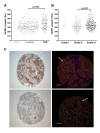
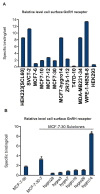
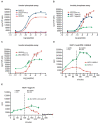
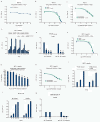
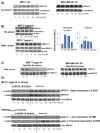
Similar articles
-
Analogs of GnRH-I and GnRH-II inhibit epidermal growth factor-induced signal transduction and resensitize resistant human breast cancer cells to 4OH-tamoxifen.Eur J Endocrinol. 2005 Oct;153(4):613-25. doi: 10.1530/eje.1.01996. Eur J Endocrinol. 2005. PMID: 16189183
-
Receptors for luteinizing hormone-releasing hormone (GnRH) as therapeutic targets in triple negative breast cancers (TNBC).Target Oncol. 2015 Sep;10(3):365-73. doi: 10.1007/s11523-014-0340-y. Epub 2014 Oct 9. Target Oncol. 2015. PMID: 25293576
-
Luteinizing hormone-releasing hormone agonist triptorelin and antagonist cetrorelix inhibit EGF-induced c-fos expression in human gynecological cancers.Gynecol Oncol. 2000 Aug;78(2):194-202. doi: 10.1006/gyno.2000.5863. Gynecol Oncol. 2000. PMID: 10926802
-
Role of gonadotropin-releasing hormone (GnRH) in ovarian cancer.Reprod Biol Endocrinol. 2003 Oct 7;1:65. doi: 10.1186/1477-7827-1-65. Reprod Biol Endocrinol. 2003. PMID: 14594454 Free PMC article. Review.
-
Intracellular signaling pathways mediated by the gonadotropin-releasing hormone (GnRH) receptor.Arch Med Res. 2001 Nov-Dec;32(6):499-509. doi: 10.1016/s0188-4409(01)00331-9. Arch Med Res. 2001. PMID: 11750725 Review.
Cited by
-
Expression of a urokinase-type plasminogen activator during tumor growth leads to angiogenesis via galanin activation in tumor-bearing mice.FEBS Open Bio. 2017 Oct 9;7(11):1784-1792. doi: 10.1002/2211-5463.12318. eCollection 2017 Nov. FEBS Open Bio. 2017. PMID: 29123986 Free PMC article.
-
Gonadotropin-releasing hormone receptor activates GTPase RhoA and inhibits cell invasion in the breast cancer cell line MDA-MB-231.BMC Cancer. 2012 Nov 23;12:550. doi: 10.1186/1471-2407-12-550. BMC Cancer. 2012. PMID: 23176180 Free PMC article.
-
Novel model for basaloid triple-negative breast cancer: behavior in vivo and response to therapy.Neoplasia. 2012 Oct;14(10):926-42. doi: 10.1593/neo.12956. Neoplasia. 2012. PMID: 23097627 Free PMC article.
-
Bioinformatics analysis of transcription profiling of solid pseudopapillary neoplasm of the pancreas.Mol Med Rep. 2017 Aug;16(2):1635-1642. doi: 10.3892/mmr.2017.6800. Epub 2017 Jun 19. Mol Med Rep. 2017. PMID: 28627654 Free PMC article.
-
Probing the GnRH receptor agonist binding site identifies methylated triptorelin as a new anti-proliferative agent.J Mol Biochem. 2012 Jun 16;1(2):86-98. J Mol Biochem. 2012. PMID: 24490142 Free PMC article.
References
-
- LHRH-agonists in Early Breast Cancer Overview group. Cuzick J, Ambroisine L, Davidson N, Jakesz R, Kaufmann M, Regan M, Sainsbury R. Use of luteinising-hormone-releasing hormone agonists as adjuvant treatment in premenopausal patients with hormone-receptor-positive breast cancer: a meta-analysis of individual patient data from randomised adjuvant trials. Lancet. 2007;369:1711–2173. - PubMed
-
- Gnant M, Mlineritsch B, Schippinger W, Luschin-Ebengreuth G, Pöstlberger S, Menzel C, Jakesz R, Seifert M, Hubalek M, Bjelic-Radisic V, Samonigg H, Tausch C, Eidtmann H, Steger G, Kwasny W, Dubsky P, Fridrik M, Fitzal F, Stierer M, Rücklinger E, Greil R. ABCSG-12 Trial Investigators. Marth C. Endocrine therapy plus zoledronic acid in premenopausal breast cancer. New Engl J Med. 2009;360:679–691. doi: 10.1056/NEJMoa0806285. - DOI - PubMed
-
- Hershkovitz E, Marbach M, Bosin E, Levy J, Roberts CT Jr, LeRoith D, Schally AV, Sharoni Y. Luteinizing hormone-releasing hormone antagonists interfere with autocrine and paracrine growth stimulation of MCF-7 mammary cancer cells by insulin-like growth factors. J Clin Endocrinol Metab. 1993;77:963–968. doi: 10.1210/jc.77.4.963. - DOI - PubMed
-
- Buchholz S, Seitz S, Schally AV, Engel JB, Rick FG, Szalontay L, Hohla F, Krishan A, Papadia A, Gaiser T, Brockhoff G, Ortmann O, Diedrich K, Köster F. Triple-negative breast cancers express receptors for luteinizing hormone-releasing hormone (LHRH) and respond to LHRH antagonist cetrorelix with growth inhibition. Int J Oncol. 2009;35:789–796. - PubMed
Publication types
MeSH terms
Substances
LinkOut - more resources
Full Text Sources
Medical
Miscellaneous

